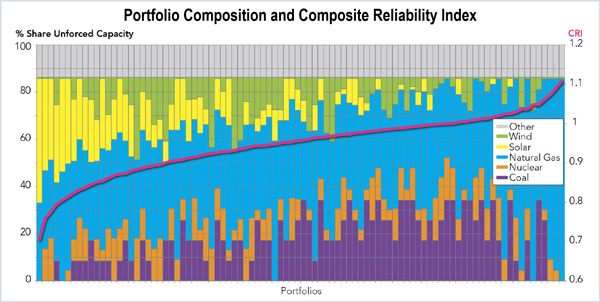By Rory D. Sweeney
PJM can maintain adequate reliability with a generation fleet almost entirely composed of natural gas units, but a capacity mix of more than 20% of solar would unacceptably increase the risk of loss-of-load events, according to a study the RTO released Thursday.
The study, titled “PJM’s Evolving Resource Mix and System Reliability,” identified essential reliability and adequacy criteria and used them to compare a wide range of potential future fuel diversity scenarios. PJM focused on generator “reliability attributes” of frequency response, voltage control, ramping ability, fuel assurance and flexibility.
PJM created a “composite reliability index” to assess the operational reliability of various resources under four conditions: normal peak conditions, light load, extremely hot weather and extremely cold weather. Resources were grouped into 11 categories: coal, natural gas steam, natural gas combustion turbine, oil steam, oil combustion turbine, nuclear, solar, wind, hydro, battery/storage and demand response.
The RTO said the report is in response to stakeholder concerns that the system is losing too many traditional baseload resources as coal plants retire and nuclear assets struggle to remain profitable.
In 2016, PJM’s installed capacity was 33% coal, 33% natural gas, 18% nuclear and 6% renewables, which include hydro. By comparison, coal and nuclear resources accounted for 91% of its generation fleet in 2005.
“This analysis underscores our responsibility to continue to operate the system reliably, and explore the role of resilience, the ability to tolerate unforeseen shocks and continue to deliver electricity,” PJM CEO Andy Ott said in a statement. “Different resources provide different reliability attributes, though new technology or regulations have the ability to improve those capabilities.”
No Upper Bound on Gas
Of particular interest, given the rise in gas-fired units interconnecting to PJM’s system, was the revelation that the there was no upper bound for the percentage of gas-fired units in the fleet before reliability is harmed.
The scenarios showed natural gas’ share of the fuel mix could rise to as high as 86% without reliability problems. Mike Bryson, PJM’s vice president of system operations, who spoke during a press briefing on the report, said staff stopped at 86% to account for demand response, hydropower and biomass currently on the system. “We figured it was a safe assumption to say they won’t go away.”
The report acknowledged, however, that it didn’t assess the gas-deliverability issues that pinched supply during January 2014 or the continued sluggishness of gas pipeline development. PJM’s previous natural gas studies generally concluded that the existing and planned pipeline infrastructure would be adequate for current and future anticipated electric system needs.
“We did not look at ability for infrastructure to support that, but we think it’s probably worthy of following up with the natural gas industry,” Bryson said. “There’s a lot of work left to do.”
The report also didn’t address the economics of resource types, factors that might impact a fuel’s deliverability or public policy issues such as environmental impacts or the use of subsidies. Bryson suggested coordination with the gas industry to begin addressing “more complicated issues” that cross over from the electricity sector, including data coordination.
That said, the report found that PJM’s current and near-term fuel mixes were near the top of the study’s reliability analyses. Less coal and nuclear generation would decrease frequency response, reactive capability and fuel assurance, but increase flexibility and ramping capabilities.
Renewables Limits
Portfolios with solar representing 20% or more of unforced capacity (UCAP) failed because they resulted in loss-of-load-expectation (LOLE) violations at night. UCAP is calculated by multiplying nameplate capacity by the resource’s capacity factor (38% for solar).
Bryson said increases in batteries and other storage would likely change the conclusions.
He added that certain fuel types were given credit for their abilities, if not their current usages. “We gave wind kind of high marks on flexibility, even though that’s not how they operate today,” he said. “The capability’s clearly there, but they don’t operate in that way.”
Fuel Diversity ≠ Reliability
The study also found that a more diverse fuel portfolio isn’t necessarily more reliable. Certain resource blends that fall between the least and most diverse offer the greatest number of key generator reliability attributes.
“Having a certain amount of diversity — not too much, not too little — gives you optimal reliability,” said PJM’s Chantal Hendrzak, who also spoke at the briefing.
However, high reliance on one type, such as gas, would create concerns that the paper didn’t attempt to analyze. PJM said it would continue to investigate ways to minimize its exposure to “low-probability, high-impact” events that could pose serious threats to the system.
“Our markets are designed to provide the incentives that the [13] states [within PJM’s footprint] need to implement their policies. We think there is an opportunity for PJM to work with the states” to determine how to harmonize well-functioning markets and public-policy initiatives, Bryson said.
The topic of reliability will be the focus of PJM’s upcoming Grid 20/20 conference scheduled for April 19.





